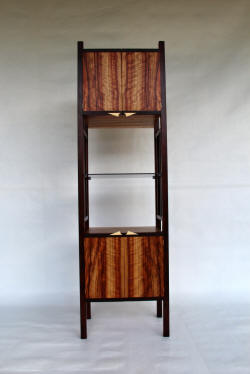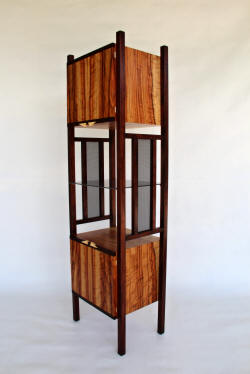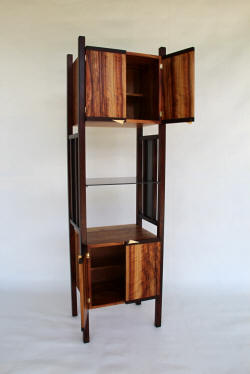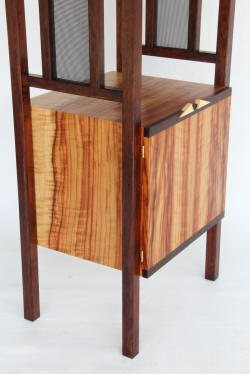|
|
The Flat Stuff Gallery
This gallery is to show that my passion for working with timber isn't exclusively wood turning.
| |
|
|
WHISKY CABINET |
|
|
|
|
|
|
|
|
|
|
|
|
|
|
|
|
|
|
|
|
|
|
|
|
|
|
|
|
|
This one is from local timbers. Acacia julifera for the sides with Milkwood for the lid/back and drawer front. |
The second has Rose-mahogany for the sides and Camphor laurel for the lid/back and drawer front. |
|
|
|
|
The finished product looks so much like the SketchUp view of my design that I just had to add this pic.Drop me a line through the feedback page if you would like a copy of the plan. |
|
|
|
|
The lids are all from Jacaranda which 'burns' really well with Borax as the conductive solution.Mackay Cedar on the left, Peltophorum on the right. |
Southern Silky Oak on the left, Red Cedar on the right. |
|
|
Both boxes are made from Sally Wattle with Norfolk Island Hibiscus mitre keys. I 'butterflied' the sides to give the appearance of continuous grain flow around the boxes and finished them with Kunos oil. The boxes are 260 x 350 x 160 mm high. |
|
|
|
|
|
|
|
|
|
|
|
|
|
|
|
|
|
|
|
|
What's left of a batch of Business card pocket boxes. Made from various Central Highlands timbers, they are designed to be used as a display stand as well. |
On the left is one in Emu Apple (closed) and on the right another made from Beefwood (open display mode). |
|
|
|
|
|
This one is made from Qld Myrtle with a White Cedar lid. |
At right is the very simple 'jig' I made on the mini-metal lathe to drill the dowels dead centre for the brass pins in the hinges. |
|
|
This project was also my first shot at hand-cut dovetails and inlaying veneer - and as long as you don't count the two drawer sides I trashed in the process, it worked out pretty well I thought!! |
In-situ with that whopping big pot-plant in place. |
|
|
|
|
|
|
|
|
|
|
|
|
My youngest boy and his wife asked for some dark coloured, 'His & Hers' cutting boards. Sally Wattle seemed the best choice for a dark colour and I used some Bitter Bark for the detail. (Note: The 'L' reads correct from either side but I don't think they've noticed yet!) Unfortunately they have apparently buckled a little since so the Sally Wattle might be a bit unstable to use for the entire board! |
And shortly after delivering those boards I realised the other offspring didn't have a decent cutting-board between them so I put this batch together from Budgeroo, Bitter Bark and a tiny bit of Sally Wattle. |
|
|
Sally Wattle box made as my entry in our club challenge competition. See how it was done here! |
|
|
An end-grain cutting board from Bitter bark, Sally wattle and Rose Mahogany (Dysoxylum fraserianum). |
|
|
A collectors cabinet from Kauri pine with Desert Oak trim. Made to house the extensive essential oil collection of my favorite client in New York (who just happens to have a mutual passion for scented timbers!) |
The bottles the oils are in range from 3cm to 9cm high, hence the 3 lift-out trays in some of the 10cm high drawers. Very happy with this project even if it took four times longer than I expected! |
|
|
|
|
|
|
A cutting board from Buloke and natural edged Gidgee. Heavy little sucker with Gidgee being in about the top 10 heaviest timbers known and Buloke being the hardest timber ever Janka tested (but not necessarily the hardest timber possible). Shouldn't dent this one in a hurry! |
|
|
|
|
|
|
|
|
|
|
This Queens-size bed is made from Sally Wattle slabs that just seemed 'right' for the job. The slats and support rails are Klinki Pine. Made using 'knock-down' brackets, it is still very sturdy but easily disassembled to be moved. |
The 'details' on the legs and covering the side-rail joins are made from Australian Ebony. The finish is Livos Kunos oil. |
|
|
|
|
A sliding-lid box from Emu Apple for my daughters heirloom pocket watch. |
|
|
A box made from Rose Mahogany (NSW Rosewood) with a River Oak burl lid insert and the tray and trimmings from Norfolk Island Hibiscus. |
This is the first project I used my 'Domino' on to strengthen the lid and foot mitre joins. The tray can be rotated to fit in the bottom of the box. |
I used 'SmartHinges' on this box as they are not only the easiest box hinges to fit, but they look so good they're hard to bypass! |
|
|
|
|
This is the first box I made once I got my Hammer C3-31 combination machine. The carcase and tray are made from Queensland Myrtle, the lid insert is spalted Tulip and the hinges and trimmings are all from Gidgee. |
|
|
|
|
|
|





























































